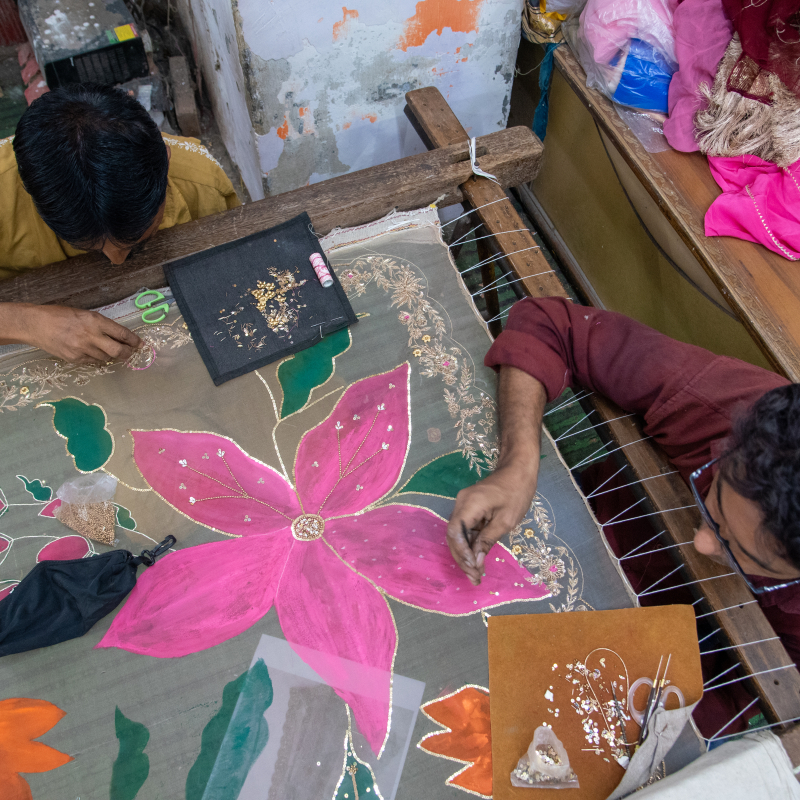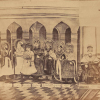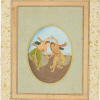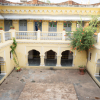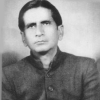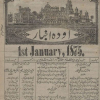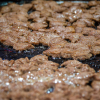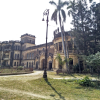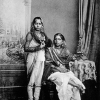While Lucknow is often associated with nawabs, kebabs and chikankari, the city’s identity runs much deeper for Lucknowis. It is essentially the city of poets, artists, karigars (artisans) and qadrdaans (connoisseurs) of literature, art and craftmanship. The crafts of mukaish and zardozi are as integral to a Lucknowi’s sartorial life as chikankari.
Chikankari
Lucknow’s signature craft, chikankari features white-on-white embroidery in which fine stitches create floral patterns and lattices on fine fabrics. While its origin—from Persia or Bengal—remains debated, its refinement in Lucknow under the patronage of the Nawabs is undisputed. Historically, as many as 32 stitches were recognised in chikankari, but over time, the repertoire has shrunk to just eight to ten predominant stitches. The Nawabi period celebrated fine jaalis, while in the 1980s, bakhiya (reverse herringbone), also known as the shadow stitch, became popular.
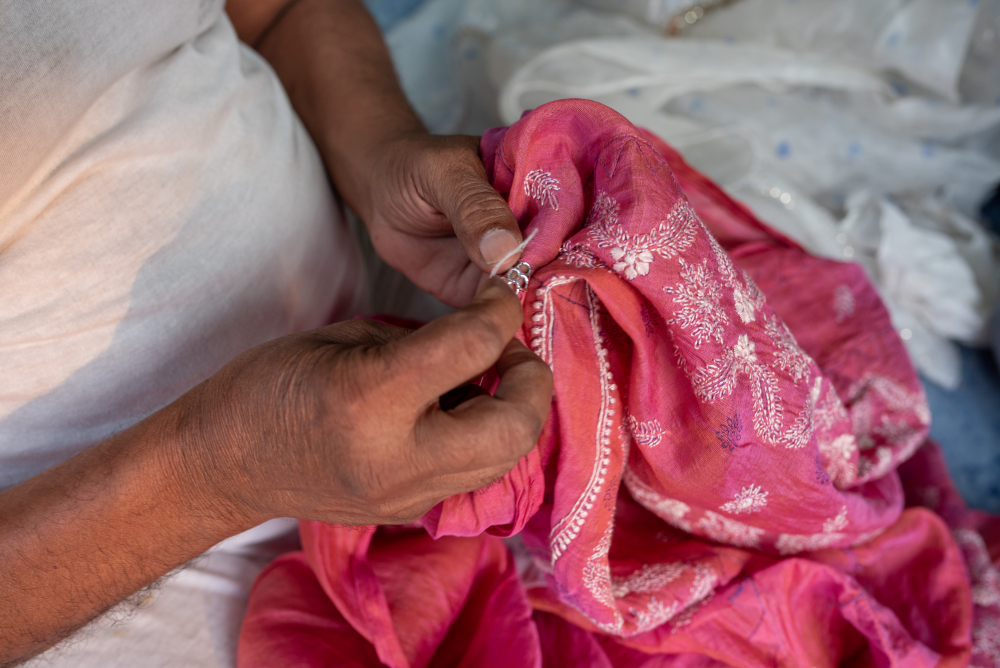
Chikankari embroidery. (Picture Credits: Monis Khan)
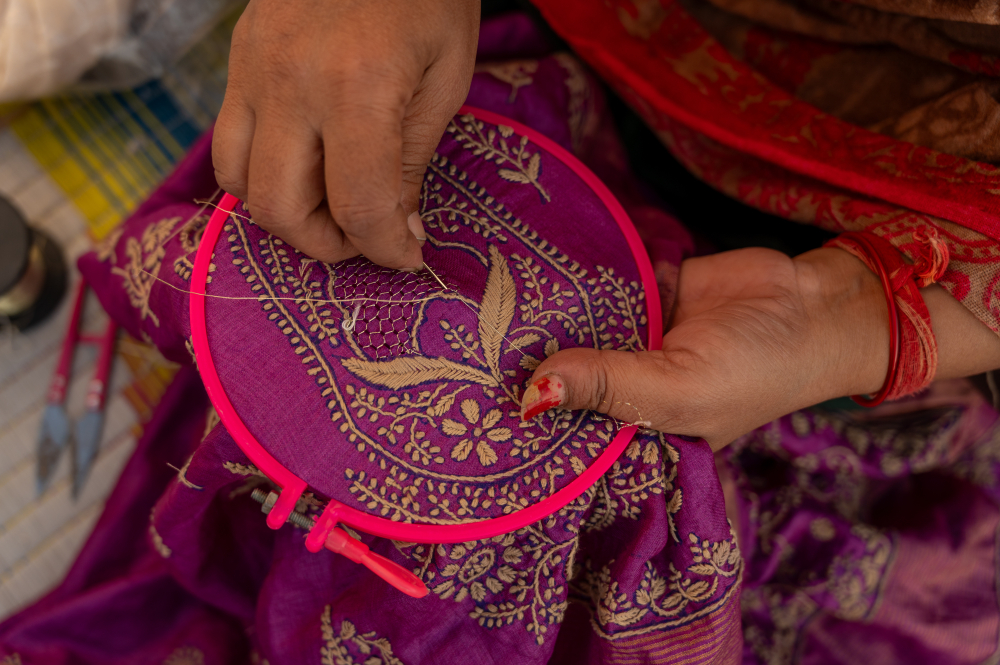
Chikankari embroidery. (Picture Credits: Monis Khan)

White-on-white chikankari. (Picture Credits: Monis Khan)
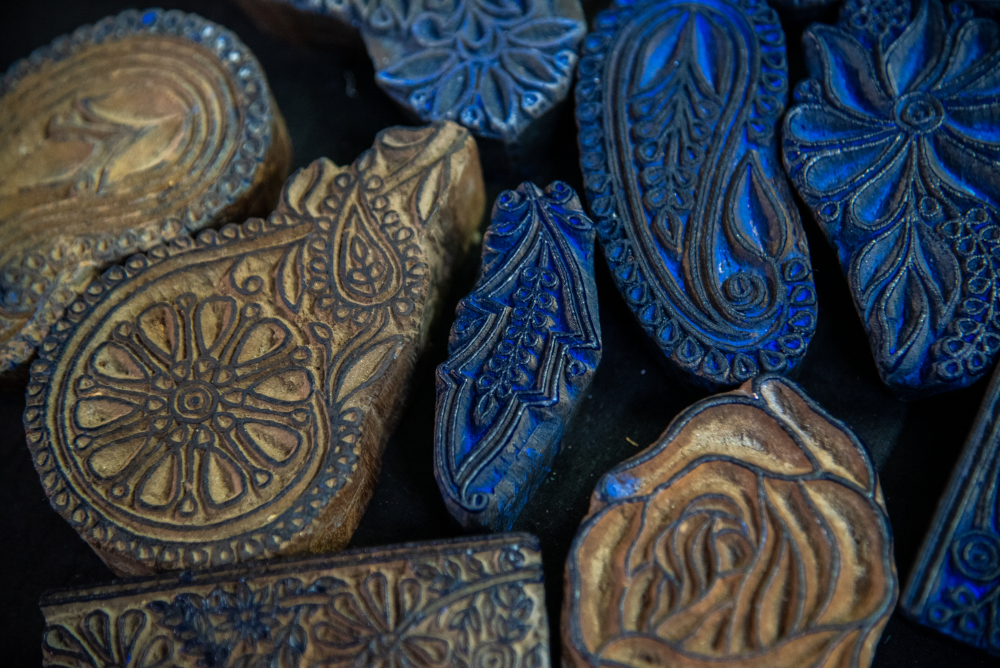
Wooden blocks are used to create patterns for the embroidery. (Picture Credits: Monis Khan)
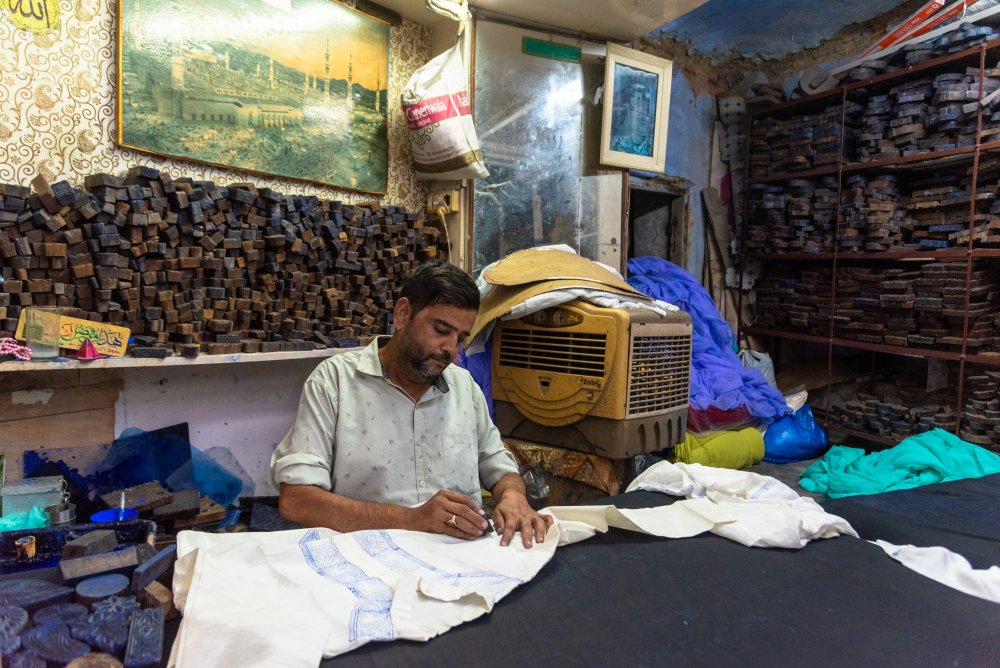
Artisan is using wooden blocks to create patterns for the embroidery. (Picture Credits: Monis Khan)
The craft experienced highs and lows in its patronage and revival, given the political turmoil in the region during the Revolt of 1857 and India’s Independence movement. With the establishment of SEWA (Self-Employed Women’s Association), stitches like murri, jaali and phanda were reintroduced. SEWA played a significant role in empowering artisans and recontextualising the craft, bringing chikankari to cities like Mumbai, Delhi and Bangalore, where it became synonymous with quality. However, SEWA’s popularity in metro cities led to the misuse of its name. Every second chikankari shop in Lucknow bears the name of SEWA (or Seva) despite having no association with the organisation.
The 1990s ushered in another chapter in chikankari’s history, as designer labels like House of Kotwara and Abu Jani Sandeep Khosla showcased it on the ramps, thus elevating it to the level of Indian couture. These designers introduced and popularizsd premium silk georgette as a base material for chikan embroidery. However, this led to several mass manufacturers using synthetic fabrics under the guise of georgette.
Celebrity Shweta Bachchan donning a Abu Sandeep chikankari lehenga for one of her pre-wedding functions made the craft acceptable as bridal wear, which was not the case earlier. At the turn of the millennium, chikankari appeared in several blockbuster films like Devdas, Kabhi Khushi Kabhie Gham and Mohabbatein, boosting even the menswear segment of chikankari.
Currently, the chikankari aesthetics are governed by social media influencers and paparazzi pictures of celebrities. Visibility of the embroidery has taken precedence over understated elegance. The delicateness of chikan can seldom be captured in photographs, therefore, the bold stitch of ghaas-patti or the ghass-patti (satin stitch) dominates the chikan mass market.
Mukaish and Kamdani
Lucknow is also known for its textile crafts of kamdani and fardi. Both crafts involve flattened wire embroidery on sheer fabric. In kamdani, the wire is used to create motifs, while fardi (literally ‘dots’) uses the same wire to create silver and gold dots arranged in patterns. The hazara butti (thousand dots) design in fardi is a signature of Lucknow. The embroidery is called mukaish in Punjab and badla in Gujarat and Mumbai; however, even Lucknowis commonly use both terms.
In the 1990s, fardi work was popular on chiffon and georgette sarees, dupattas and kurtas. However, as finesse declined and finishing quality deteriorated, fardi became uncomfortable due to the wire irritating the skin. With the rise of chikan couture, mukaish and kamdani have regained attention as complementary crafts.

Kamdani, mukaish, and fardi are intricate metallic embellishment techniques to add shimmer, texture, and sparkle to traditional embroidery. (Picture Credits:Monis Khan)
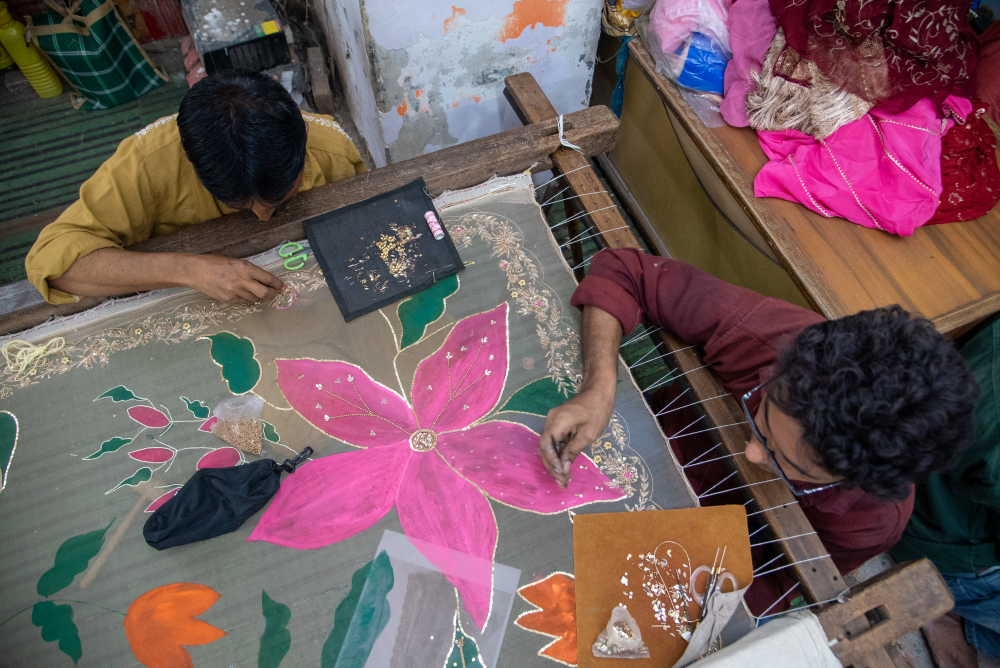
Artisans executing Zardozi work which involves the use of metallic wires (zari), needles, and adda (wooden frame) to create raised motifs on fabric. (Picture Credits: Monis Khan)
Chatapati
Chatapati, a lesser-known craft from the Awadh region, involves creating geometric patterns with fabric pieces that are cut, stitched and embroidered together. It has two variations—one where strips of four or more colours are stitched in various patterns (diagonal, vertical, horizontal or zigzag), and another where tukris (small pieces) are joined to create a multicoloured pattern. This variation is also referred to as tukriyon ka kaam. Tukris can be triangular, square, octagonal or diamond-shaped, with a fish-scale pattern (called mahipusht) being most popular among Awadhi women. Chatapati patterns are often embellished with kamdani, salma-sitara or zardozi work. The craft found its finest expression in Awadhi gararas, beautifully captured in director Muzaffar Ali’s film Umrao Jaan (1981).
Zardozi
Before chikankari and mukaish entered the bridal couture realm, zardozi was the preferred craft for bridal wear. The term karchobi often encompassed all zari-based embroideries done on a frame—called adda or karchob—including aari and dabka work. Luxurious fabrics like velvet and chenille were favoured for zardozi menswear, with velvet also commonly used for women’s blouses and kurtas.
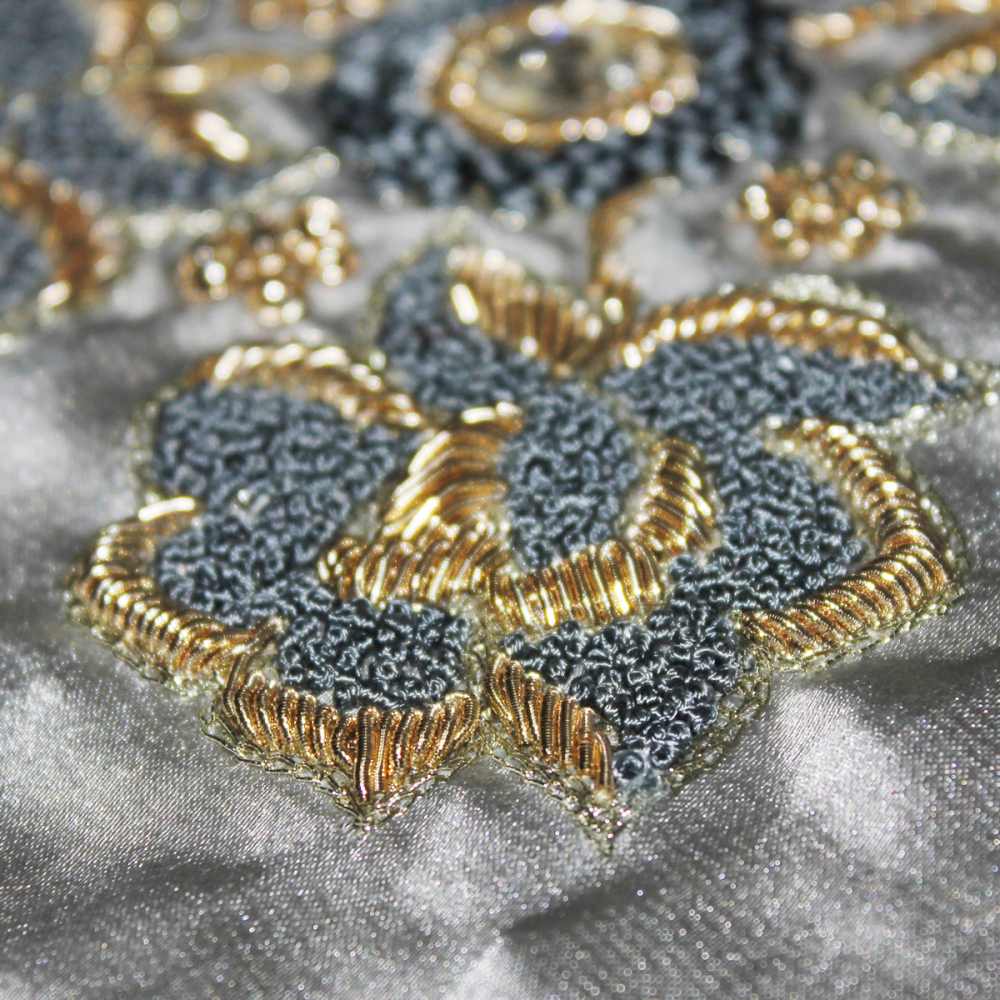
Zardozi work. (Picture Credits: Zarood/Wikimedia Commons)

Zardozi incorporates the use of gold and silver threads, dabka, sequins, pearls, and beads to create intricate, raised patterns on fabric. (Picture Credits: Monis Khan)
In the 1990s, the specific style of zardozi known as salma-sitara became popular, featuring salma (short wiggles of wire) and sitara (sequins). This style often included contrasting appliqués on the base fabric, with tiny leaf shapes made of salma scattered across. The base was typically tissue silk, with replicas made on synthetic tissue. However, this style began to feel outdated by the early 2000s, though a revival is underway thanks to designer labels like Divani.
Leheriya
Awadhi leheriya is primarily a non-commercial home craft practised by women from old Awadhi families. Its dyeing process differs significantly from the more popular tie-and-dye method. A thick cotton dori (string) is soaked in various dye vats and then pressed onto fabric folded twice. As the dye-soaked dori is pressed, the colour transfers through the layers, revealing patterns once opened. The dyed fabric is then dried and crinkled to enhance the wave or leheriya effect, a process known as chunaai. Optionally, it may be edged with gota or finished with heavier embroidery like kamdani or fardi.
As the joint family system disintegrated and lifestyles changed, this craft saw a sharp decline. Although this craft was also featured in Umrao Jaan, it failed to gain enough attention for a revival. Organisations like Sanatkada are working to bring Awadh’s leheriya into the commercial realm to ensure its survival.
In Lucknow, for most embroidery crafts, except karchobi, the creative force and its skilled execution reside predominantly with women. These artisans, often working within the intimate spaces of their homes, are the custodians of generations-old techniques. While men may facilitate aspects of production and distribution, the very soul of these traditions is woven by female hands. Consequently, ethical purchasing of authentic craft products serves not only as a direct investment in the livelihoods of these talented women but also as a crucial act of preserving their invaluable cultural legacy.
This essay has been created as part of Sahapedia's My City My Heritage project, supported by the InterGlobe Foundation (IGF).
